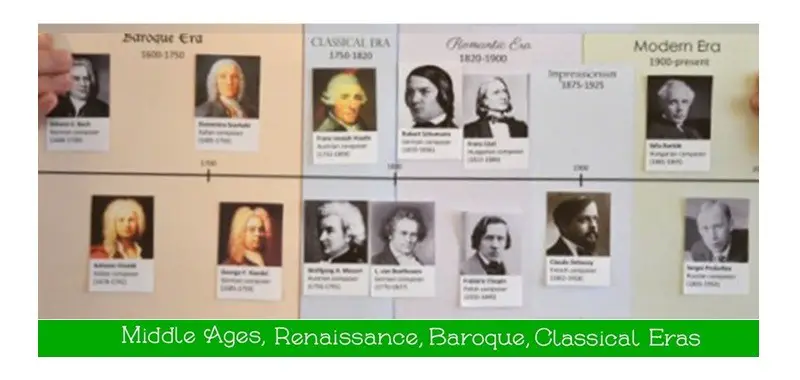
If you know even a bit about classical music, chances are that you know that even classical music is classified as those from various periods (eras). And assuming you’re aware of it, do you recollect if Beethoven was a Classical composer, or was he from the Romantic era? Doesn’t matter if you’re not aware, here’s a easy guide to the various periods in the western classical music and the various popular composers from that era.
Today classical music is reproduced in many forms. It has found its way into the popular domain in advertising jingles and in the musical scores of some movies. Nevertheless, love for classical music in its original form still lives on. For example, there are many classical music lovers who continue to experience the grandeur of Mozart’s works at home on CD or attend specially held recitals to marvel at the maestro that Mozart was.
What is Western Classical Music
When you think of western classical music you immediately think of maestros like Wolfgang Amadeus Mozart and Ludwig Van Beethoven. The definition of western classical music however has evolved over time.
The term Western Classical Music focuses primarily on the development of music in the European region. It generally refers to music that has its roots in western art, ecclesiastical (church) music, and concert music.
Music has evolved over the ages, having been influenced by various traditions, developments in technology, etc. Each stage of this evolution has been classified into a certain period. Classical music chiefly evolved within the Classical period. However, to understand western classical music you will also need to know some notable developments prior to and post the Classical period.
Music History & Genres: Composer Timelines for Various Music Periods
Classical music falls under various eras such as Baroque period, Classical Period, Renaissance period, romantic Era.
Main periods/eras of classical music, and who the main composers were during that time:
- 20th Century Music: Modern period where classical works is inspired by jazz, folk and native music.
- Romantic Period: Music from (1820-1910), filled with emotion, intense energy and passion, this era produced some fantastic works.
- Classical Period: Music from (1750-1820), saw the introduction of a form (sonata form) that has dominated instrumental composition to the present day. the focus was more on balance and structure.
- Baroque Period / Era: Music from (1600-1750), an era that saw an explosion of styles and forms. Music in that era was known for its intricate ornamentation.
- Renaissance Period: Music from the 14th to 16th centuries, an era of re-birth and discovery for composers. Characterized by increase of secular music, madrigals, and art song
- Early Music: Medieval and Pre-Renaissance Music from the 6th to the 15th Century, the era that laid the foundations for the composers that were to come. Characterized by Gregorian chant, mostly religious.
Take a journey through the various historical periods of classical music from Medieval up to the Contemporary period.
- You can find music from the Medieval period, which is often considered as the earliest period in the history of classical music spanning the years 800 to 1400.
- Move on to the second period in classical music history, the Renaissance which covers the period from 1400 to 1600.
- The third period in classical music history is Baroque, a great period that produced musical geniuses such as J.S. Bach, Vivaldi, Telemann and Handel among many others. This was from the years 1600 to 1750.
- The Classical period covers the years from 1750 to 1830. Notable composers of this period in classical music history include Mozart and Haydn.
- The next period in classical music history is Romantic during the 19th Century. It is also referred as the century of Nationalism.
- What follows is the 20th Century characterized by an enormous variety of musical styles and forms.
- The most recent period in the history of classical music is, of course, the Contemporary period which covers the music of living composers who continue to compose in the 21st century.
Prior to the Classical Period
The origins of western classical music can be traced back to the middle ages. Around 500 AD, one of the major influences in music was the Catholic Church. Pope Gregory I is said to have codified the Gregorian chant. Once the chat was documented and standardised it became a base for most tunes of the time. The tunes of the Gregorian chant were monophonic, consisting of a single melody. There was no harmonic support or accompaniment to this.
In the University of Notre Dame, the Organum was created in the ninth century. The organum consisted of two melodic lines sung simultaneously or at intervals. Usually two lead singers would start simultaneously and then would start to sing in intervals gradually increasing the gap between intervals. It was only during the Renaissance period that tunes started to become polyphonic in nature. After the Renaissance, the major development in music was Baroque which was around 1600 to 1750. This highly ornamental style of music was popularised by eminent composers such as Johann Sebastian Bach. Their most favoured instruments were the pipe organ and the harpsichord. During the Baroque period, the instrumental concerto became famous and is found in the works of Antonio Vivaldi. It was in this period that the opera was born in Italy and even German born composer George Fredric Handel composed his operas in this period.
Source: indiaparenting.com
KeytarHQ editorial team includes musicians who write and review products for pianists, keyboardists, guitarists & other musicians. KeytarHQ is the best online resource for information on keyboards, pianos, synths, keytars, guitars and music gear for musicians of all abilities, ages and interests.



Leave a Reply